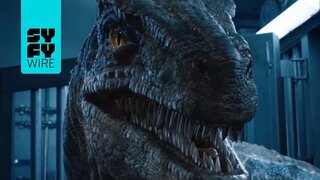Create a free profile to get unlimited access to exclusive videos, sweepstakes, and more!
Reconstructing the Voices of Dinosaurs: The Science Behind Jurassic Park III
Real world scientists are hard at work recovering the lost voices of extinct creatures.
If Jurassic Park III (streaming now on Peacock) is about anything (aside from dino fights), it’s about communication. Dr. Alan Grant (Sam Neill) struggles to communicate his love of conventional paleontology to a public enamored by John Hammond’s creations, and that’s just for a start. When he reconnects with Dr. Ellie Sattler (Laura Dern), Grant tries talking with Sattler’s pet parrot (the first example of dinosaur communication in the film, but not the last) before the pair of them reminisce about the sounds that raptors make.
Dr. Grant is researching raptor intelligence the old fashioned way, by digging up bones, but with the benefit of some modern technology, circa 2001. He and his team produce 3D scans of fossilized raptors to recreate their resonating chambers. With the help of what looks like an early 3D printer, they can craft a handheld dinosaur voice box. Grant is convinced that vocalization allowed raptors to coordinate attacks and work together, he believes that communication was the key to their intelligence.
When funding dries up, Grant agrees to play tour guide during a flyover of Isla Sorna (InGen’s site B) in exchange for the money he needs to support his work. The thing is, Grant has no idea of his clients’ real intentions. He ends up face to face with prehistoric killers once again because of a lack of communication. And once he’s on the island, he hears the raptors using precise vocalizations, exactly as he predicted. He even hears a raptor speaking English, kind of.
Any visit to Jurassic Park requires a certain suspension of disbelief, but Dr. Grant’s methods for investigating the vocalizations of extinct animals had a clawed toe in reality.
For More on Dinosaurs:
How Smart Were Rexy and her Tyrannosaur Friends? Scientists Disagree
We're Celebrating the Dinosaur Bicentennial in 2024
Dinosaur vs. Mammal, a Fight Etched in Stone
How Paleontologists Uncover the Many Voices of Dinosaurs
In the movies, we tend to give dinosaurs ferocious, spine-tingling roars. It’s cinematically appropriate and, more than that, it just feels right. Sadly, it’s very likely inaccurate. Those theatrical roars and squawks that so effectively bring velociraptors and T. rexes to life onscreen were created by mashing up the sounds of living animals who have different biology than the dinosaurs.
Like living animals, dinosaurs probably made a variety of sounds which differed between species and individuals. Certainly, a lumbering sauropod with their necks the length of a school bus would have made different noises than a small theropod. There’s no single answer to what dinosaurs sounded like, but paleontologists have been able to dial in on the sounds some species may have made.
While soft tissues rarely fossilize, scientists have been able to reconstruct resonating chambers just like in the movie. By blowing air through them, scientists can hear the sorts of sounds those chambers were capable of making, even if we can’t know how they were used in context. Researchers find other clues by comparing the body structures of extinct animals with those of living ones, especially their living relatives like crocodilians and birds.
Depending on the species, dinosaurs may have had sound producing organs similar to the larynx or syrinx, which are used to produce a wide range of sounds in modern animals. However, evidence of these organs is hard to come by in the fossil record. Still, dinosaurs probably made sounds in other ways, using inflatable cavities, esophageal pouches, or head-mounted crests. The crests of Parasaurolophus are essentially enlarged nasal passages which may have been used to produce honks like some modern birds.
Large predators like the T. rex, by contrast, may have made closed-mouthed vocalizations by rushing air through their esophagus. Rather than a roar, those kinds of vocal calls would have come out as a low-pitched growl or cooing sound, rumbling through the Cretaceous forest.
Researchers also find clues in the fossilized ears of dinosaurs. The structure of the ear and even they layout of the braincase can give scientists clues about the kinds of sounds an animal is capable of hearing. The thinking goes that any animal will adapt to hear sounds which are important to them, which include the vocalizations of their peers. The truth is, we’ll probably never know precisely what the prehistoric world sounded like, but we can pretty confidently guess they couldn’t say “Alan.”
Jurassic Park III (and the rest of the Jurassic Park collection) is streaming now on Peacock.
















































